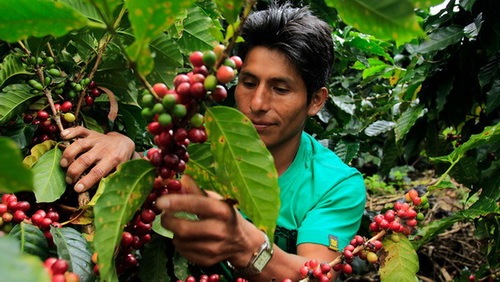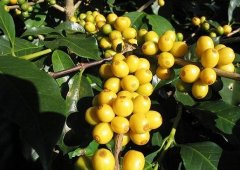Guatemala Antigua Flower Flower Flavor Coffee Flavor description Jane

Antigua Valley is Guatemala's oldest and best-known coffee-producing region. Volcanoes and shallow water tables create a dry microclimate characterized by low humidity, plenty of sun and cool nights.
Antigua is an enclosed valley surrounded by three volcanoes: Agua, Acatenango and Fuego. Antigua is flat and slightly sloping, unlike other coffee producing areas located in volcanic areas.
Most coffee trees are grown in the heart of the valley, but even so, elevation has reached 5000 feet; in addition, some farmers grow coffee on the slopes of volcanoes, at elevations approaching 5600 feet.
The extremely high pumice content of Antigua soil (from the active Fuego volcano) keeps humidity constant at 65% year-round, which is very different from other volcanic coffee producing areas, where humidity usually varies greatly between dry and wet seasons.
Fertile volcanic soils, low humidity, plenty of sunshine and cool nights all make Antigua unique.
The majestic three volcanoes Agua, Acatenango and Fuego surround Antigua Valley. Every once in a while, Fuego-one of three active volcanoes in Guatemala-adds fresh ash rich in minerals to Antigua's soil. Volcanic pumice in the soil keeps the soil moist, making up for Antigua's low rainfall-the lowest of Guatemala's eight coffee-producing regions.
Like all Guatemala specialty coffees, Antigua coffee is grown in shade. In Antigua, shade is mainly used to protect coffee trees from frost, which sometimes occurs during the colder nights from December to February. The dense shade and shallow aquifers combine to create a unique microclimate for the coffee trees that inhabit it. Antigua coffee dates back to the Mayan civilization. Due to volcanic eruptions, the soil here is more nutritious, and sufficient sunlight and moisture also make the coffee produced excellent quality. Most importantly, the residents here insist on growing Arabica bourbon coffee, although the yield is small, but the quality is better. Antigua's inhabitants, who grow coffee on a large scale, like to harvest it all at once and use the ancient sun method to remove the skin and pulp from the coffee fruit. People pluck ripe fruit and unripe fruit together, even mixing leaves with them and spreading them out in the sun. When spread on the ground for a long time, coffee beans easily absorb the impurities of the soil, so they often have an odd salty taste. The taste is often unbearable to first-time tasters, but people who are used to it like it. Coffee farmers in Antigua earn very little. But they say they are happy, even in poverty, because of coffee. Antigua coffee is soft and has a slightly charred taste, just like chocolate sweetness mixed with smoke. This charcoal-burning incense sticks to nearby areas and erupts every 30 years, allowing coffee trees to soak up the nitrogen gas that erupts during major eruptions. Because of this unique charcoal-burning aroma, Antigua coffee is also known as "cigarette coffee". In fact, coffee produced in other countries near volcanoes also contains similar smoke, but not as pure as Antigua coffee. Almost all coffees produced in Antigua retain this unique smoke flavor to the greatest extent. Among them, the most authentic coffee is produced in Kamana Farm, which has always been regarded as
The National Revolutionary Union of Guatemala was formed by the merger of the National Left Guerrillas, and armed struggle spread throughout the country. Peasants dissatisfied with the overthrow of the Árbenz regime organized a guerrilla army, in which over 100,000 people died and millions were displaced. In September 1982, Guatemala's army persecuted the local Mayan people, bordering on genocide, killing more than 9000 Mayans. Beginning in 1983, persecution on the part of the Government of Guatemala began to decrease and the country resumed democratization. However, the inequality between the rich and the poor in the country has not been solved, and only a minority of 1 per cent owns more than 60 per cent of arable land and wealth. In 1985, Guatemala reorganized the general election. Guatemala is located in the tropics. The northern and eastern coastal plain areas belong to tropical rain forest climate, and the southern mountains belong to subtropical climate. There are two dry and wet seasons in a year. The wet season is from May to October, and the dry season is from November to April of the following year. Guatemala has a tropical climate on the narrow, fertile plains of the Pacific Ocean. The central plateau is also the cultural center of Guatemala, where temperatures are mild all year round at 1300 to 1800 meters, with daily temperatures ranging from 18 to 28 ° C, and colder January and February at higher altitudes. Annual precipitation of 2000-3000 mm in the northeast and 500-1000 mm in the south is surrounded by three majestic volcanoes, Agua, Acatenango and Fuego. Every once in a while, Fuego-one of three active volcanoes in Guatemala-adds fresh ash rich in minerals to Antigua's soil. Volcanic pumice in the soil keeps the soil moist, making up for Antigua's low rainfall-the lowest of Guatemala's eight coffee-producing regions.
Like all Guatemala specialty coffees, Antigua coffee is grown in shade. In Antigua, shade is mainly used to protect coffee trees from frost, which sometimes occurs during the colder nights from December to February. The dense shade combined with the shallow aquifer creates a unique microclimate for the coffee trees that inhabit it.
Antiguan Coffee Reviews:
Aroma 7.8; Flavor 7.85; Acidity 7.95; Balance 7.63; Overall 7.78; Alcohol 7.85; Aftertaste 7.60
Delicate, balanced, rich in aroma and excellent in sweetness, Antigua Valley is Guatemala's oldest and best known coffee growing region. Volcanoes and shallow water tables create a dry microclimate characterized by low humidity, plenty of sun and cool nights.
Antigua is an enclosed valley surrounded by three volcanoes: Agua, Acatenango and Fuego. Antigua is flat and slightly sloping, unlike other coffee producing areas located in volcanic areas.
Most coffee trees are grown in the heart of the valley, but even so, elevation has reached 5000 feet; in addition, some farmers grow coffee on the slopes of volcanoes, which are close to 5600 feet above sea level.
The extremely high pumice content of Antigua soil (from the active Fuego volcano) keeps humidity constant at 65% year-round, which is very different from other volcanic coffee producing areas, where humidity usually varies greatly between dry and wet seasons.
Fertile volcanic soil, low humidity, plenty of sunshine and cool nights all make up Antigua's unique "Antigua Flower God" from the high altitude in the heart of Antigua's volcanic region. Costa Rica's famous La Minita Estate provides the highest standard of planting and treatment technology in the industry, and directly sends personnel to Antigua to participate in quality control, and commissions Antigua's largest and most equipped Bastor washing plant.(Pastores mill) to the highest standards of post-harvest processing, under the supervision of the Lamini quality control personnel green bean handling and cup testing control, established a strict set of procedures from the procurement of coffee berries to washing, sun and drying, so this coffee has an outstanding performance is not surprising
Important Notice :
前街咖啡 FrontStreet Coffee has moved to new addredd:
FrontStreet Coffee Address: 315,Donghua East Road,GuangZhou
Tel:020 38364473
- Prev

Gentle and supple Costa Rican Tarazu boutique coffee beans grind degree baking degree treatment method simple
Tarazhu is very famous in the world of boutique coffee and is one of the major coffee producing areas in the world. In the 2014 COE competition, of the 23 beans on the list, 17 came from Tarasu. Tarasu is located in the fertile volcanic region of Central America, which has a humid climate and fertile volcanic soil, abundant rainfall throughout the year, high altitude, and dense forest natural shade.
- Next

A brief introduction to the Origin, Development, History and Culture of Guatemala Antigua Flower God Fine Coffee beans
Under the influence of this climate, coffee trees blossom and bear fruit more slowly than coffee trees in other parts of the world. However, the mild climate and fertile soil make it an excellent environment for growing coffee. The coffee produced in Guatemala is one of the top coffees in the world because of its high-altitude volcanic topography. These volcanoes are the ideal places to grow coffee. With other varieties
Related
- Detailed explanation of Jadeite planting Land in Panamanian Jadeite Manor introduction to the grading system of Jadeite competitive bidding, Red bid, Green bid and Rose Summer
- Story of Coffee planting in Brenka region of Costa Rica Stonehenge Manor anaerobic heavy honey treatment of flavor mouth
- What's on the barrel of Blue Mountain Coffee beans?
- Can American coffee also pull flowers? How to use hot American style to pull out a good-looking pattern?
- Can you make a cold extract with coffee beans? What is the right proportion for cold-extracted coffee formula?
- Indonesian PWN Gold Mandrine Coffee Origin Features Flavor How to Chong? Mandolin coffee is American.
- A brief introduction to the flavor characteristics of Brazilian yellow bourbon coffee beans
- What is the effect of different water quality on the flavor of cold-extracted coffee? What kind of water is best for brewing coffee?
- Why do you think of Rose Summer whenever you mention Panamanian coffee?
- Introduction to the characteristics of authentic blue mountain coffee bean producing areas? What is the CIB Coffee Authority in Jamaica?

